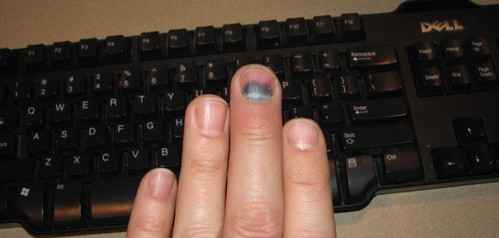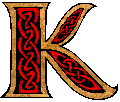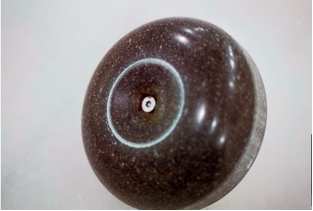
I'm too nice a guy to throw up just the finger. Here's all four. Note the result of bouncing a fifty pound car battery off the middle one of the group. Typing's gonna be a bitch for a while.
March 31, 2009
My finger, let me show it to you...
March 30, 2009
The ABCs of...skepticism?
He's an astronomer by education, and profession. Not a bad astronomer, but The Bad Astronomer. He's a successful writer. He's the president of the James Randi Educational Foundation. He's a...a poet?
...D is Debunker, it's said with a jeer
But we cannot debunk without bunk, that is clear...
Who knew?
But that whole "ABCs of" idea...You come up with that yourself, Phil? I'm skeptical.
March 28, 2009
The ABCs of Curling - L
 is for Line, the path the rock follows as it travels down the ice. In order to hit an opposition rock, or draw behind a guard, the line the rock follows is very important. Because a rock will begin to curl more as it slows down, and sweeping a rock helps it maintain its momentum longer, the players will sweep a rock to make it curl less, or stop sweeping to allow it to curl more, as desired.
is for Line, the path the rock follows as it travels down the ice. In order to hit an opposition rock, or draw behind a guard, the line the rock follows is very important. Because a rock will begin to curl more as it slows down, and sweeping a rock helps it maintain its momentum longer, the players will sweep a rock to make it curl less, or stop sweeping to allow it to curl more, as desired.
This brings us to the age old question: why do curling rocks curl? It is an interesting question, but an even more interesting question is: why do curling rocks curl in the direction that they do? When you throw a curling rock, and impart a clockwise spin to it, it will curl to your right as it moves away from you down the ice. This seems to make sense.
Here's an experiment for you to try. Take a small drinking glass, and turn it upside down. The rim of the glass simulates the running surface of the rock, as we saw in I is for Ice. Slide the upside-down glass down your kitchen counter, while spinning it clockwise, as if you were throwing a curling rock. You will see that the glass curves to the (wait, what?) to the left, as it travels along the counter. The exact opposite to what a curling rock does. What's going on here?
The answer has to do with the only recently understood physics of the interaction between the gaseous, liquid, and solid states of water at the interface between the air and the surface of a sheet of ice, and the changes to that interface under the pressure exerted by the weight of a running rock.
It's pretty sciency stuff, so I'll forgive you if you don't want to click through, but here is an article by University of Northern British Columbia physics professor Mark Shegelski that describes the effect, and here is a neato flash presentation from the University of Toronto that illustrates it.
<- Start at the beginning.
March 27, 2009
Friday random ten
Haven't done one of these for a while. Here are the first ten songs randomly loaded onto my iPod during my last update.
1) Security - Joss Stone
2) Lady Sings The Blues - Billie Holiday
3) The King Of The Golden Hall - London Philharmonic Orchestra (from the Lord of the Rings: The Two Towers soundtrack)
4) Gone For A Long Time - The Johnstones
5) Fully Alive - Flyleaf
6) A Pillow Of Winds - Pink Floyd
7) Don't Damn Me - Guns 'N' Roses
8) Trust Me (This Is Love) - Amanda Marshall
9) Do What You Like - Blind Faith
10) My Imagination - Wide Mouth Mason
March 22, 2009
The ABCs of Curling - K
 is for Kilsyth, a small town in central Scotland, about halfway between Glasgow and Stirling. Near the old Roman Antonine Wall, Kilsyth is situated on the main east-west route across the narrowest part of Scotland. It is also, according to many, the birthplace of modern curling.
is for Kilsyth, a small town in central Scotland, about halfway between Glasgow and Stirling. Near the old Roman Antonine Wall, Kilsyth is situated on the main east-west route across the narrowest part of Scotland. It is also, according to many, the birthplace of modern curling.
There are many claimed birthplaces of curling in Scotland. The earliest known curling stone, inscribed with the date 1511, was found at the bottom of a pond in Dublane, near Stirling. The earliest known written mention of a contest played on ice using stones comes from the records of Paisley Abbey, in Renfrewshire, dated 1541.
Kilsyth, however, does hold a credible claim to having organised the sport into something akin to the game we play today. The Colzium estate, just outside the town proper, boasts one of the earliest known man-made curling ponds, dating to the early eighteenth century, and the Kilsyth curling club, officially constituted in 1716 and still extant today, is considered the world's first formalised club.
<- Start at the beginning.
March 14, 2009
The ABCs of Curling - J
 is for Jitney, an informal curling outing. Not part of regular league play, and really too small to be considered a bonspiel, a Jitney may encompass one or two games, but winning and losing takes a back seat to fun and friendship. The off-ice socializing after the games is just as important as the games themselves at a Jitney.
is for Jitney, an informal curling outing. Not part of regular league play, and really too small to be considered a bonspiel, a Jitney may encompass one or two games, but winning and losing takes a back seat to fun and friendship. The off-ice socializing after the games is just as important as the games themselves at a Jitney.
J is for Juniors. Junior curlers, separated into three divisions: little rocks - ages 6-12, bantam - ages 12-16, and junior - ages 16-20, are the lifeblood of any curling club. While membership drives to bring in new adult curlers are important to the health of any club, those curlers who start at an early age become the most avid and competitive club members. Today's juniors are tomorrow's champions.
J is for Jennifer Jones, a six time Canadian Women's Champion, two time World Champion, and 2014 Olympic Champion curler from Manitoba. Jennifer is a former Junior national champion as well.
[edited 09/22/2019 to update Jennifer Jones' record]
Start at the beginning
March 12, 2009
Something to celebrate?
There has been a fair amount of squawk in the atheist/humanist blogosphere over the recently announced results of the latest American Religious Identification Survey, ARIS 2008.The survey appears to show a significant increase in the number of atheists and agnostics in America, accompanied by a matching drop in numbers of Catholics and Protestants. There has been much hooting and hurrahing, and raising of hands in celebration, as if this were some kind of victory, in some kind of contest.
Leaving aside the question of whether or not this is an appropriate thing to celebrate, I'm not sure the celebrants are feting the right thing. I don't know that they are correctly interpreting these results. Are there really more non-religious people in the USA now then there were in 2001, the last time this study was undertaken? Or is something else going on?
The most important point to remember is that this is a study of religious self-identification. What do you call yourself? The secular community has always recognised that the non-religious have long been under represented in surveys. Most non-religious people are not activist atheists; they are just people for whom religion has no place in their lives. They never think about it. But if they were raised in a Catholic, or Baptist, or Jewish household, that's the little tick they make on the survey. It is an answer stemming from culture, rather than religious belief in many cases.
Over the past eight years, we've seen a dramatic upsurge in the visibility of atheism and secularism in our every day lives. There are a couple of different reasons for this.
First, we've seen several best-selling books on atheism from authors such as Christopher Hitchens, Sam Harris, and Richard Dawkins. Additionally, the advent of the popularity of blogging has many people expressing themselves in ways they never have before - and many more able to easily find information on atheism/agnosticism than ever.
Second, there have been several high profile court cases dealing with seperation of church and state issues. Along with focus on the previous administration's rather liberal (heh) interpretation of the constitution, these have brought secularism under a microscope in America in a way it never has been before.
The offshoot of all this is that more Americans than ever before are thinking about what it means to be agnostic, or to be an atheist. More Americans than ever before are considering whether or not the USA truly is a nation founded on Christian ideals, as the religious right would have you believe, or whether it was, in fact, envisioned and created as a secular nation.
More Americans are looking at that questionaire, and stopping, and thinking, "what am I?" There aren't really more atheists in America than there were eight years ago. There are just more people willing to be honest when answering that survey than there were before.
And maybe there is cause to celebrate that.
March 11, 2009
The ABCs of Curling - I
 is for Ice, upon which the game of curling is played. The playing surface of a sheet of curling ice is between 146 and 150 feet long, and between 14 feet 6 inches and 16 feet 5 inches wide. Most clubs have four or six sheets of ice (well, it's only one big sheet, usually, but it's got multiple playing surfaces laid out on it). While there are some curling clubs that share an arena with an ice skating or hockey rink, most clubs have their own facility. Curling ice and Hockey ice are different enough to make sharing a rink undesirable.
is for Ice, upon which the game of curling is played. The playing surface of a sheet of curling ice is between 146 and 150 feet long, and between 14 feet 6 inches and 16 feet 5 inches wide. Most clubs have four or six sheets of ice (well, it's only one big sheet, usually, but it's got multiple playing surfaces laid out on it). While there are some curling clubs that share an arena with an ice skating or hockey rink, most clubs have their own facility. Curling ice and Hockey ice are different enough to make sharing a rink undesirable.
First of all, hockey ice is usually much thicker than curling ice - more than double the thickness in most cases. Ice that thick used for curling results in very heavy conditions. The curlers have to throw the rocks really hard to get them to the other end. When a high profile curling event, like the Brier, is held in an ice skating facility, the ice makers will spend several days slowly scraping down the ice surface until it is thin enough to make good curling ice.
The other big difference between skating ice and curling ice - the one most people immediately notice upon stepping onto the playing surface - is that curling ice is not smooth. The surface is "pebbled" by sprinkling water droplets on it from a specially designed watering can.
Likewise, the bottom of a curling stone is not smooth either. Or flat. As seen in the picture to the right, the surface is concave, and only a thin circle of stone actually touches the ice. This circle, about ¼ inch thick, is roughened, or sharpened, or textured (depending on who you talk to). The result of the rough running edge of the rock, and the pebble on the ice is a significantly reduced surface area of rock and ice actually in contact with each other.
Reduced surface area translates to reduced friction, and allows the rock to travel as far as it does. If you were to try and throw a smooth bottomed stone across smooth ice, you'd have a hard time gettting it to go fifty feet, much less the one hundred and fifty needed to get to the far end of the sheet.
<- Start at the beginning.
March 10, 2009
An experiment
Try this:
Stand up. Bend over as far as you can. Put your head down between your knees. Just hold that position for a minute while I get the camera. Only joking. OK, ready? Now, stand back up as fast as you can. Whoa! Feel woozy? Room spinning? Most people have experienced what is commonly called a "head rush" before. Imagine feeling that way all the time; every minute of every day. Welcome to my world.
It started with a cold. You know, sore throat, cough, runny nose, sinus congestion. After four or five days with no let-up, I visited my doctor, and she felt there was a good chance it was a bacterial infection, and prescribed some anti-biotics. That afternoon Mr. Vertigo came to visit, and my world, quite literally, turned topsy-turvy.
For three days I couldn't stand up without the room reeling around me, my stomach roiling and threatening to jettison its contents. I could sit on the couch and read for short periods of time, but would quickly have to retreat to my bed when the dizziness and nausea became overwhelming. Two nights running my wife had to hold my head while I retched over the toilet at 2:00 AM, brought on simply by sitting up in bed to take some cold and sinus medication. Finally, on the third day, she dragged me back to see the doctor again.
"It's a virus," she said (the doctor). She had made me turn my head this way and that, push or pull back my arms and legs against resistance in a number of positions. She had shined a light in my eyes to check my pupillary response, checked my reflexes with that pointy little hammer, and asked me a myriad of questions - all to rule out a neurological cause. I don't have a brain tumor. "It's a virus," she said. "It's found its way into your middle ear, which is the physical center of balance control for your body." That's why I have to hold onto the walls to walk from the bedroom to the bathroom.
The worst of it should be over in a week to ten days, she told me, but the balance problems could persist, off and on, for three to six weeks. Three to six weeks! I've already been off work for eight days (and missed six curling games, damn it). Another week, and I'll have exhausted my accrued vacation pay, and be incomeless. And while the nausea has abated, I still feel like I have a head rush for most of every day. I'm unsteady on my feet, slow-moving, and slow-witted.
Curse you, Rhinovirus!
On another note, Celle dropped by to say hello the other day. She has a new blog, and is hoping you'll all go visit her. I have no idea who Celle is, or how she stumbled across AWV. Still, she asked nicely.






